The Impact of Social Stratification on Early Childhood Education
VerifiedAdded on 2022/07/27
|8
|1964
|24
Essay
AI Summary
This essay delves into the pervasive issue of social stratification within early childhood education, defining it as unequal access to resources and opportunities based on social groups, primarily focusing on socioeconomic status. It explores the historical context and societal factors contributing to this stratification, highlighting the impact of family dynamics and economic disparities on children's access to quality education. The essay examines the consequences for educators, who often face resource limitations and the need to support students from disadvantaged backgrounds. Furthermore, it analyzes the effects on children and families, including challenges in meeting basic needs and developmental setbacks. The paper also touches on the political dimensions of social stratification, including unequal participation and influence in democratic processes. Finally, it proposes policy recommendations such as asset-building for working families, administrative changes, and legislative action to mitigate the effects of social stratification and promote equitable access to educational opportunities.
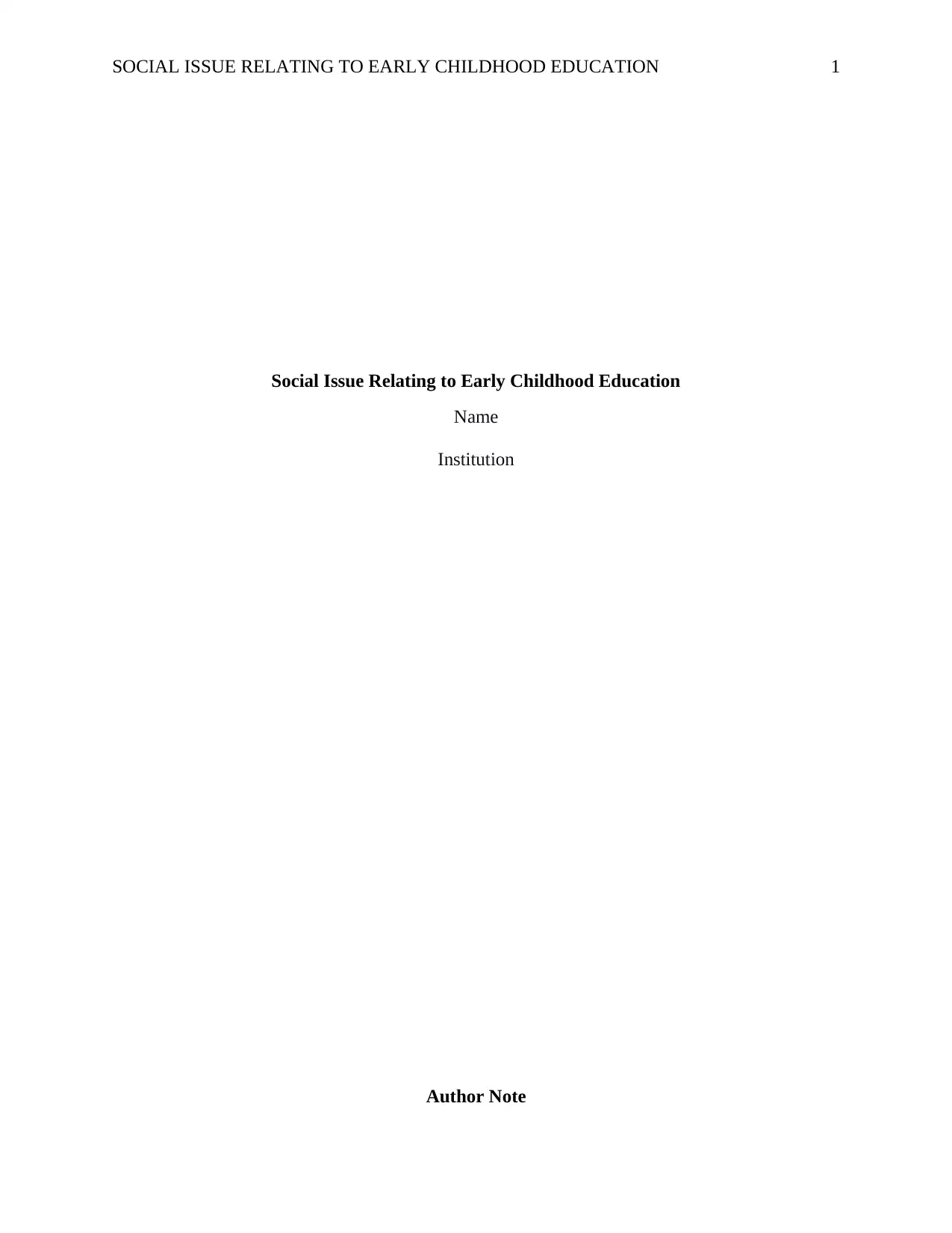
SOCIAL ISSUE RELATING TO EARLY CHILDHOOD EDUCATION 1
Social Issue Relating to Early Childhood Education
Name
Institution
Author Note
Social Issue Relating to Early Childhood Education
Name
Institution
Author Note
Paraphrase This Document
Need a fresh take? Get an instant paraphrase of this document with our AI Paraphraser
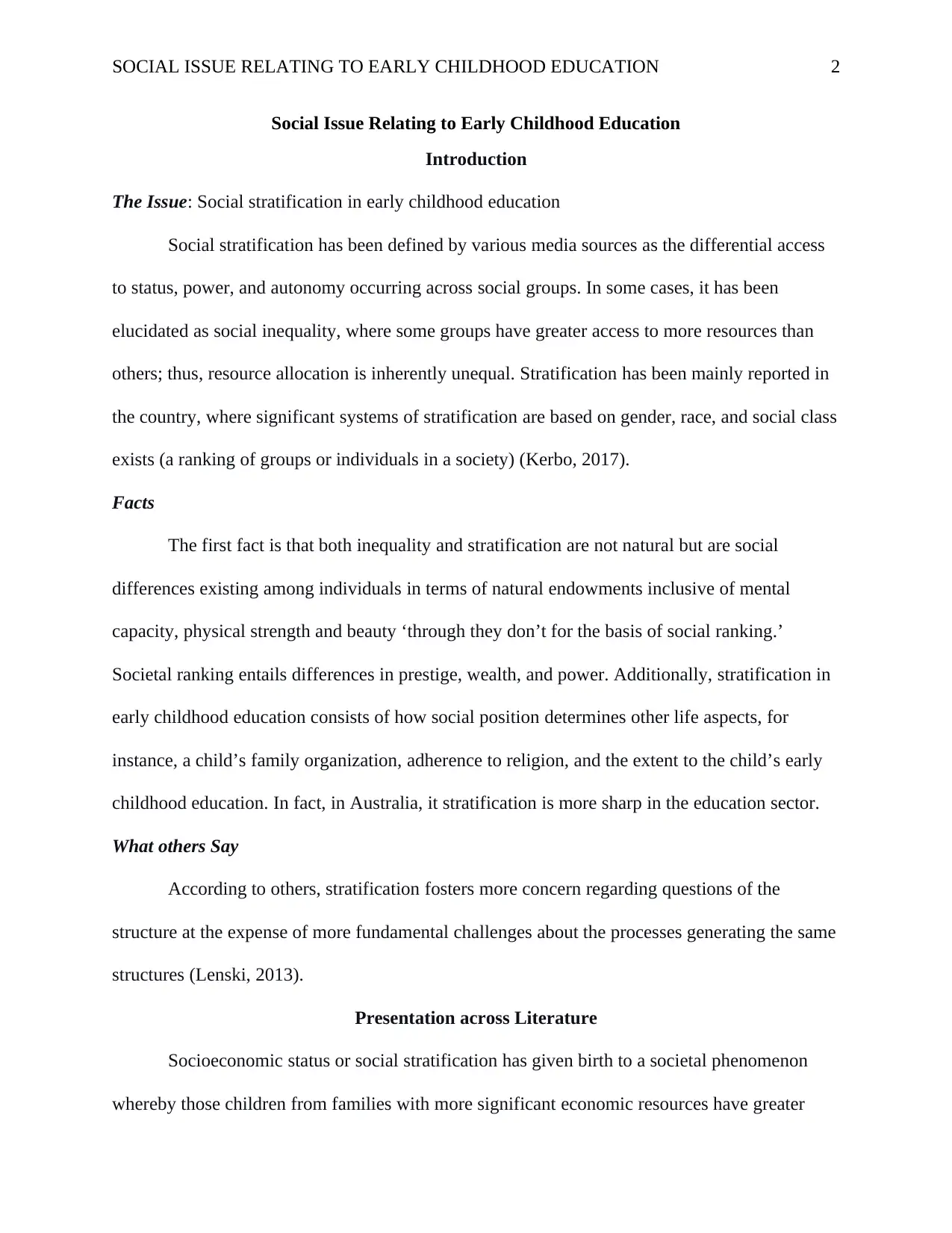
SOCIAL ISSUE RELATING TO EARLY CHILDHOOD EDUCATION 2
Social Issue Relating to Early Childhood Education
Introduction
The Issue: Social stratification in early childhood education
Social stratification has been defined by various media sources as the differential access
to status, power, and autonomy occurring across social groups. In some cases, it has been
elucidated as social inequality, where some groups have greater access to more resources than
others; thus, resource allocation is inherently unequal. Stratification has been mainly reported in
the country, where significant systems of stratification are based on gender, race, and social class
exists (a ranking of groups or individuals in a society) (Kerbo, 2017).
Facts
The first fact is that both inequality and stratification are not natural but are social
differences existing among individuals in terms of natural endowments inclusive of mental
capacity, physical strength and beauty ‘through they don’t for the basis of social ranking.’
Societal ranking entails differences in prestige, wealth, and power. Additionally, stratification in
early childhood education consists of how social position determines other life aspects, for
instance, a child’s family organization, adherence to religion, and the extent to the child’s early
childhood education. In fact, in Australia, it stratification is more sharp in the education sector.
What others Say
According to others, stratification fosters more concern regarding questions of the
structure at the expense of more fundamental challenges about the processes generating the same
structures (Lenski, 2013).
Presentation across Literature
Socioeconomic status or social stratification has given birth to a societal phenomenon
whereby those children from families with more significant economic resources have greater
Social Issue Relating to Early Childhood Education
Introduction
The Issue: Social stratification in early childhood education
Social stratification has been defined by various media sources as the differential access
to status, power, and autonomy occurring across social groups. In some cases, it has been
elucidated as social inequality, where some groups have greater access to more resources than
others; thus, resource allocation is inherently unequal. Stratification has been mainly reported in
the country, where significant systems of stratification are based on gender, race, and social class
exists (a ranking of groups or individuals in a society) (Kerbo, 2017).
Facts
The first fact is that both inequality and stratification are not natural but are social
differences existing among individuals in terms of natural endowments inclusive of mental
capacity, physical strength and beauty ‘through they don’t for the basis of social ranking.’
Societal ranking entails differences in prestige, wealth, and power. Additionally, stratification in
early childhood education consists of how social position determines other life aspects, for
instance, a child’s family organization, adherence to religion, and the extent to the child’s early
childhood education. In fact, in Australia, it stratification is more sharp in the education sector.
What others Say
According to others, stratification fosters more concern regarding questions of the
structure at the expense of more fundamental challenges about the processes generating the same
structures (Lenski, 2013).
Presentation across Literature
Socioeconomic status or social stratification has given birth to a societal phenomenon
whereby those children from families with more significant economic resources have greater
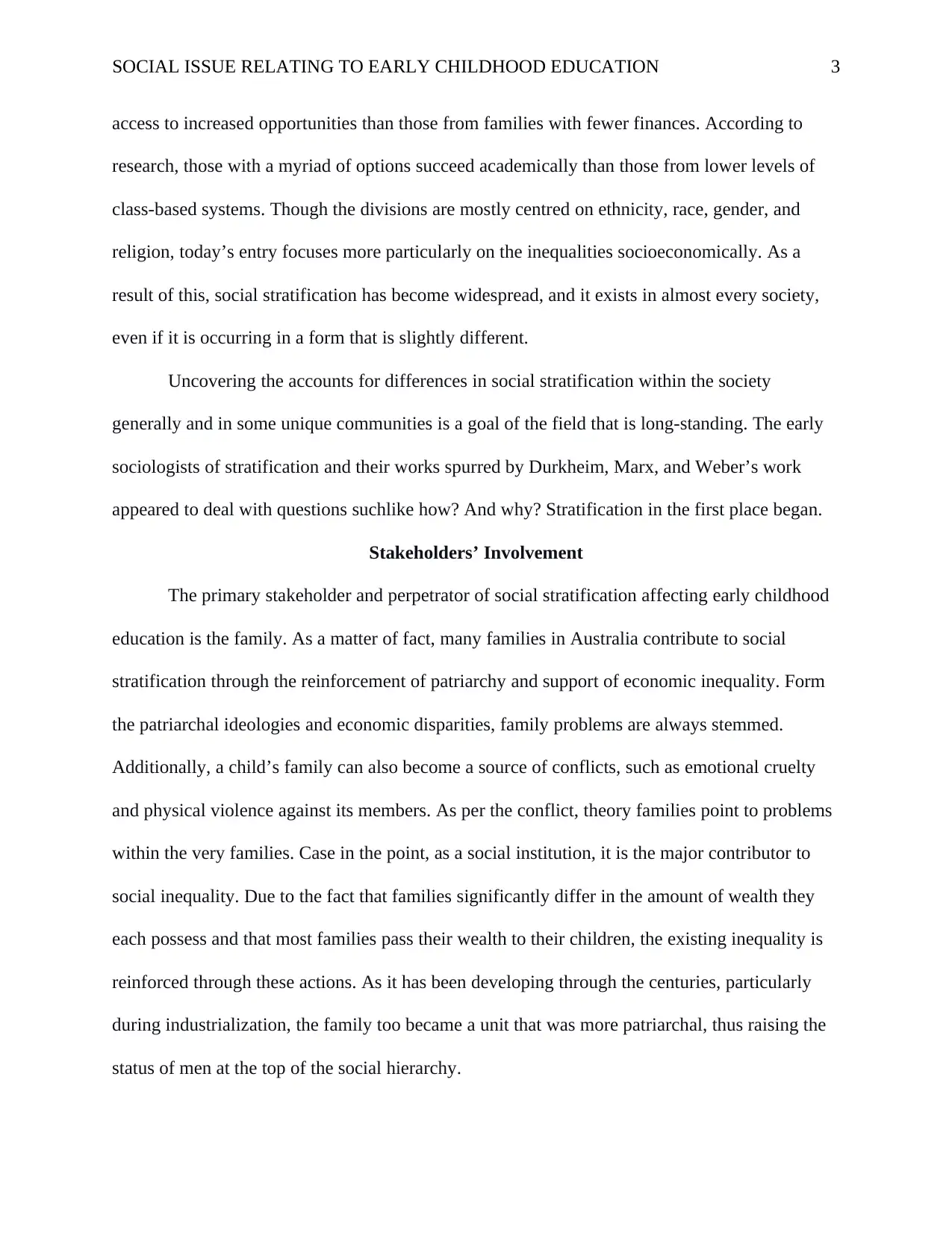
SOCIAL ISSUE RELATING TO EARLY CHILDHOOD EDUCATION 3
access to increased opportunities than those from families with fewer finances. According to
research, those with a myriad of options succeed academically than those from lower levels of
class-based systems. Though the divisions are mostly centred on ethnicity, race, gender, and
religion, today’s entry focuses more particularly on the inequalities socioeconomically. As a
result of this, social stratification has become widespread, and it exists in almost every society,
even if it is occurring in a form that is slightly different.
Uncovering the accounts for differences in social stratification within the society
generally and in some unique communities is a goal of the field that is long-standing. The early
sociologists of stratification and their works spurred by Durkheim, Marx, and Weber’s work
appeared to deal with questions suchlike how? And why? Stratification in the first place began.
Stakeholders’ Involvement
The primary stakeholder and perpetrator of social stratification affecting early childhood
education is the family. As a matter of fact, many families in Australia contribute to social
stratification through the reinforcement of patriarchy and support of economic inequality. Form
the patriarchal ideologies and economic disparities, family problems are always stemmed.
Additionally, a child’s family can also become a source of conflicts, such as emotional cruelty
and physical violence against its members. As per the conflict, theory families point to problems
within the very families. Case in the point, as a social institution, it is the major contributor to
social inequality. Due to the fact that families significantly differ in the amount of wealth they
each possess and that most families pass their wealth to their children, the existing inequality is
reinforced through these actions. As it has been developing through the centuries, particularly
during industrialization, the family too became a unit that was more patriarchal, thus raising the
status of men at the top of the social hierarchy.
access to increased opportunities than those from families with fewer finances. According to
research, those with a myriad of options succeed academically than those from lower levels of
class-based systems. Though the divisions are mostly centred on ethnicity, race, gender, and
religion, today’s entry focuses more particularly on the inequalities socioeconomically. As a
result of this, social stratification has become widespread, and it exists in almost every society,
even if it is occurring in a form that is slightly different.
Uncovering the accounts for differences in social stratification within the society
generally and in some unique communities is a goal of the field that is long-standing. The early
sociologists of stratification and their works spurred by Durkheim, Marx, and Weber’s work
appeared to deal with questions suchlike how? And why? Stratification in the first place began.
Stakeholders’ Involvement
The primary stakeholder and perpetrator of social stratification affecting early childhood
education is the family. As a matter of fact, many families in Australia contribute to social
stratification through the reinforcement of patriarchy and support of economic inequality. Form
the patriarchal ideologies and economic disparities, family problems are always stemmed.
Additionally, a child’s family can also become a source of conflicts, such as emotional cruelty
and physical violence against its members. As per the conflict, theory families point to problems
within the very families. Case in the point, as a social institution, it is the major contributor to
social inequality. Due to the fact that families significantly differ in the amount of wealth they
each possess and that most families pass their wealth to their children, the existing inequality is
reinforced through these actions. As it has been developing through the centuries, particularly
during industrialization, the family too became a unit that was more patriarchal, thus raising the
status of men at the top of the social hierarchy.
⊘ This is a preview!⊘
Do you want full access?
Subscribe today to unlock all pages.

Trusted by 1+ million students worldwide
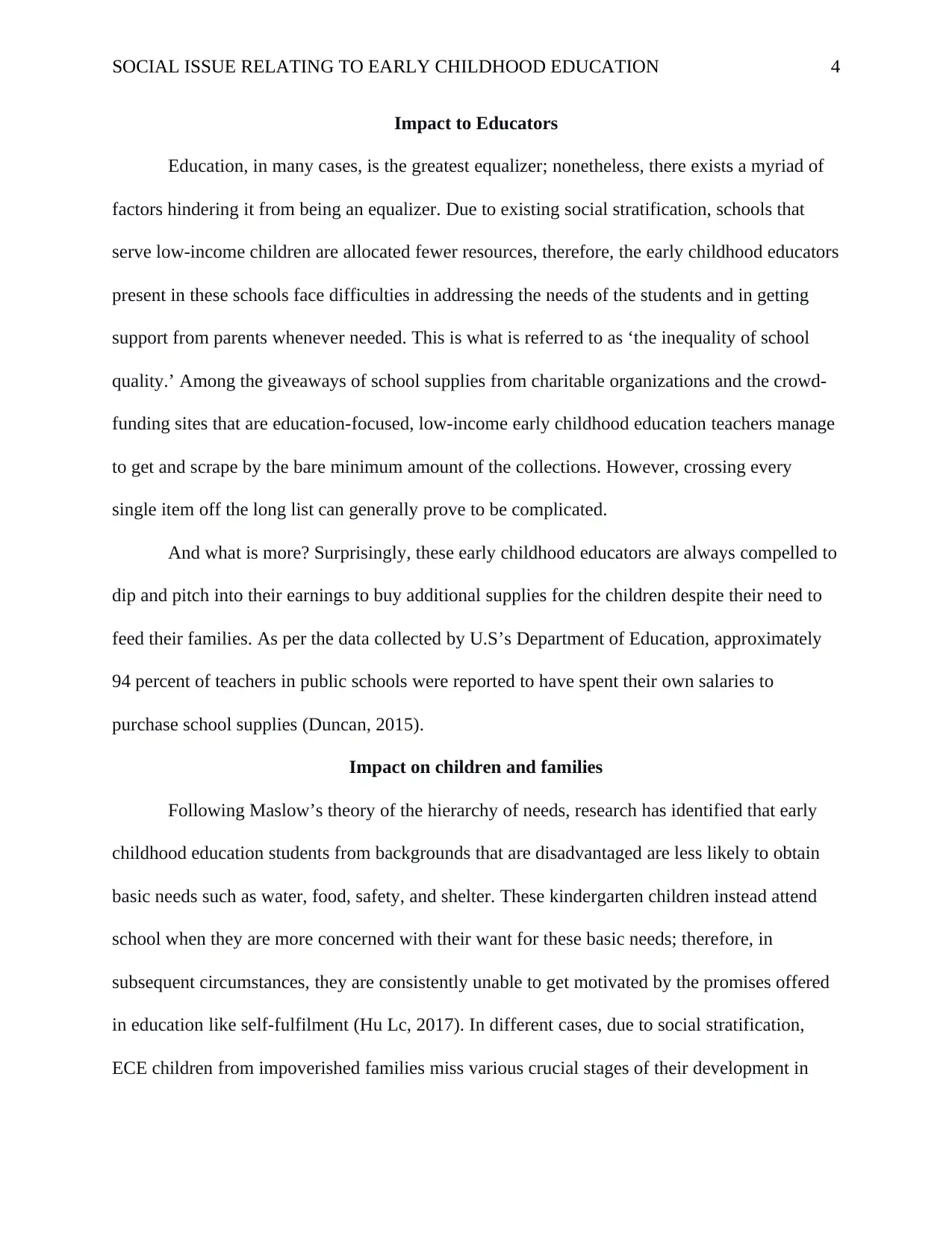
SOCIAL ISSUE RELATING TO EARLY CHILDHOOD EDUCATION 4
Impact to Educators
Education, in many cases, is the greatest equalizer; nonetheless, there exists a myriad of
factors hindering it from being an equalizer. Due to existing social stratification, schools that
serve low-income children are allocated fewer resources, therefore, the early childhood educators
present in these schools face difficulties in addressing the needs of the students and in getting
support from parents whenever needed. This is what is referred to as ‘the inequality of school
quality.’ Among the giveaways of school supplies from charitable organizations and the crowd-
funding sites that are education-focused, low-income early childhood education teachers manage
to get and scrape by the bare minimum amount of the collections. However, crossing every
single item off the long list can generally prove to be complicated.
And what is more? Surprisingly, these early childhood educators are always compelled to
dip and pitch into their earnings to buy additional supplies for the children despite their need to
feed their families. As per the data collected by U.S’s Department of Education, approximately
94 percent of teachers in public schools were reported to have spent their own salaries to
purchase school supplies (Duncan, 2015).
Impact on children and families
Following Maslow’s theory of the hierarchy of needs, research has identified that early
childhood education students from backgrounds that are disadvantaged are less likely to obtain
basic needs such as water, food, safety, and shelter. These kindergarten children instead attend
school when they are more concerned with their want for these basic needs; therefore, in
subsequent circumstances, they are consistently unable to get motivated by the promises offered
in education like self-fulfilment (Hu Lc, 2017). In different cases, due to social stratification,
ECE children from impoverished families miss various crucial stages of their development in
Impact to Educators
Education, in many cases, is the greatest equalizer; nonetheless, there exists a myriad of
factors hindering it from being an equalizer. Due to existing social stratification, schools that
serve low-income children are allocated fewer resources, therefore, the early childhood educators
present in these schools face difficulties in addressing the needs of the students and in getting
support from parents whenever needed. This is what is referred to as ‘the inequality of school
quality.’ Among the giveaways of school supplies from charitable organizations and the crowd-
funding sites that are education-focused, low-income early childhood education teachers manage
to get and scrape by the bare minimum amount of the collections. However, crossing every
single item off the long list can generally prove to be complicated.
And what is more? Surprisingly, these early childhood educators are always compelled to
dip and pitch into their earnings to buy additional supplies for the children despite their need to
feed their families. As per the data collected by U.S’s Department of Education, approximately
94 percent of teachers in public schools were reported to have spent their own salaries to
purchase school supplies (Duncan, 2015).
Impact on children and families
Following Maslow’s theory of the hierarchy of needs, research has identified that early
childhood education students from backgrounds that are disadvantaged are less likely to obtain
basic needs such as water, food, safety, and shelter. These kindergarten children instead attend
school when they are more concerned with their want for these basic needs; therefore, in
subsequent circumstances, they are consistently unable to get motivated by the promises offered
in education like self-fulfilment (Hu Lc, 2017). In different cases, due to social stratification,
ECE children from impoverished families miss various crucial stages of their development in
Paraphrase This Document
Need a fresh take? Get an instant paraphrase of this document with our AI Paraphraser
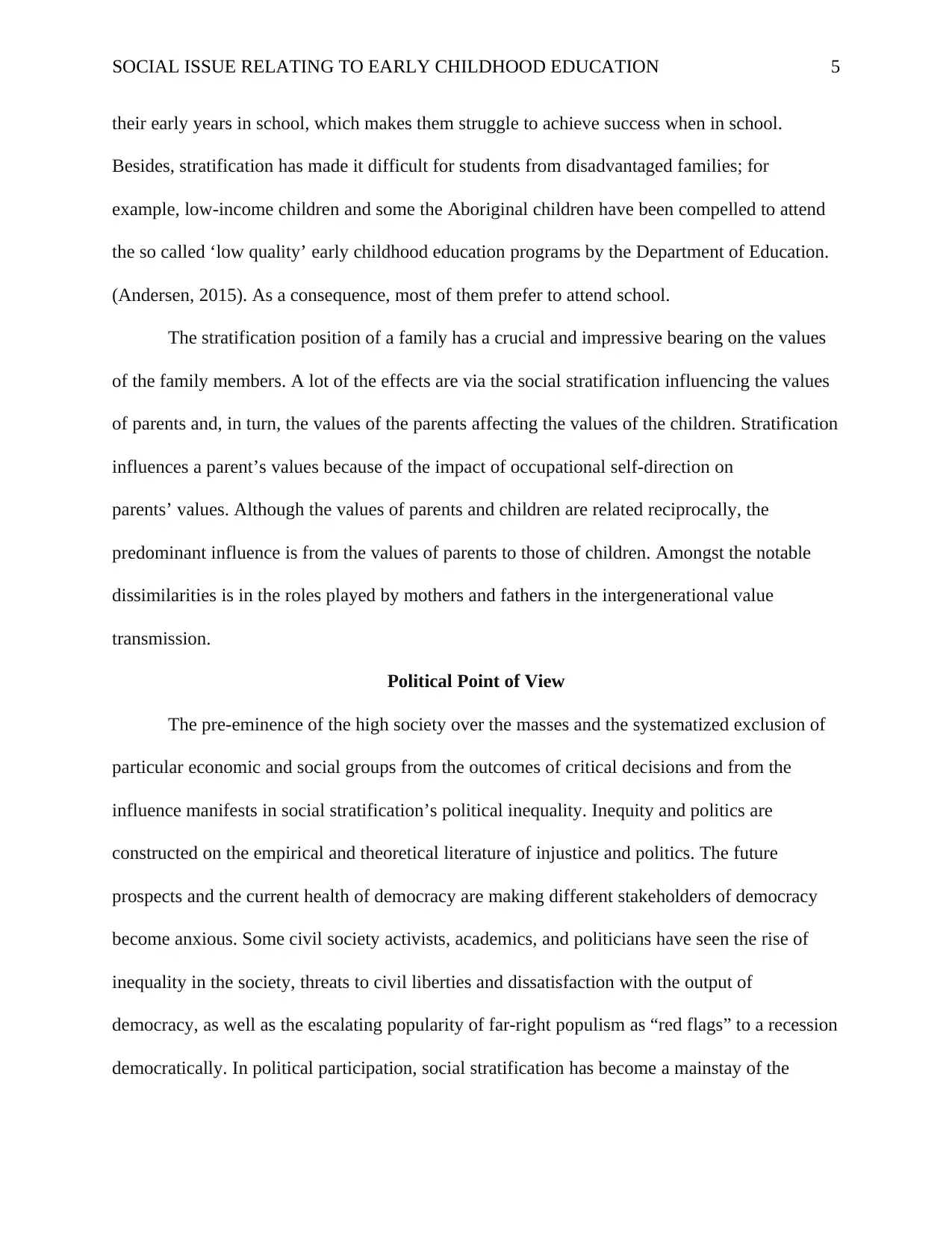
SOCIAL ISSUE RELATING TO EARLY CHILDHOOD EDUCATION 5
their early years in school, which makes them struggle to achieve success when in school.
Besides, stratification has made it difficult for students from disadvantaged families; for
example, low-income children and some the Aboriginal children have been compelled to attend
the so called ‘low quality’ early childhood education programs by the Department of Education.
(Andersen, 2015). As a consequence, most of them prefer to attend school.
The stratification position of a family has a crucial and impressive bearing on the values
of the family members. A lot of the effects are via the social stratification influencing the values
of parents and, in turn, the values of the parents affecting the values of the children. Stratification
influences a parent’s values because of the impact of occupational self-direction on
parents’ values. Although the values of parents and children are related reciprocally, the
predominant influence is from the values of parents to those of children. Amongst the notable
dissimilarities is in the roles played by mothers and fathers in the intergenerational value
transmission.
Political Point of View
The pre-eminence of the high society over the masses and the systematized exclusion of
particular economic and social groups from the outcomes of critical decisions and from the
influence manifests in social stratification’s political inequality. Inequity and politics are
constructed on the empirical and theoretical literature of injustice and politics. The future
prospects and the current health of democracy are making different stakeholders of democracy
become anxious. Some civil society activists, academics, and politicians have seen the rise of
inequality in the society, threats to civil liberties and dissatisfaction with the output of
democracy, as well as the escalating popularity of far-right populism as “red flags” to a recession
democratically. In political participation, social stratification has become a mainstay of the
their early years in school, which makes them struggle to achieve success when in school.
Besides, stratification has made it difficult for students from disadvantaged families; for
example, low-income children and some the Aboriginal children have been compelled to attend
the so called ‘low quality’ early childhood education programs by the Department of Education.
(Andersen, 2015). As a consequence, most of them prefer to attend school.
The stratification position of a family has a crucial and impressive bearing on the values
of the family members. A lot of the effects are via the social stratification influencing the values
of parents and, in turn, the values of the parents affecting the values of the children. Stratification
influences a parent’s values because of the impact of occupational self-direction on
parents’ values. Although the values of parents and children are related reciprocally, the
predominant influence is from the values of parents to those of children. Amongst the notable
dissimilarities is in the roles played by mothers and fathers in the intergenerational value
transmission.
Political Point of View
The pre-eminence of the high society over the masses and the systematized exclusion of
particular economic and social groups from the outcomes of critical decisions and from the
influence manifests in social stratification’s political inequality. Inequity and politics are
constructed on the empirical and theoretical literature of injustice and politics. The future
prospects and the current health of democracy are making different stakeholders of democracy
become anxious. Some civil society activists, academics, and politicians have seen the rise of
inequality in the society, threats to civil liberties and dissatisfaction with the output of
democracy, as well as the escalating popularity of far-right populism as “red flags” to a recession
democratically. In political participation, social stratification has become a mainstay of the
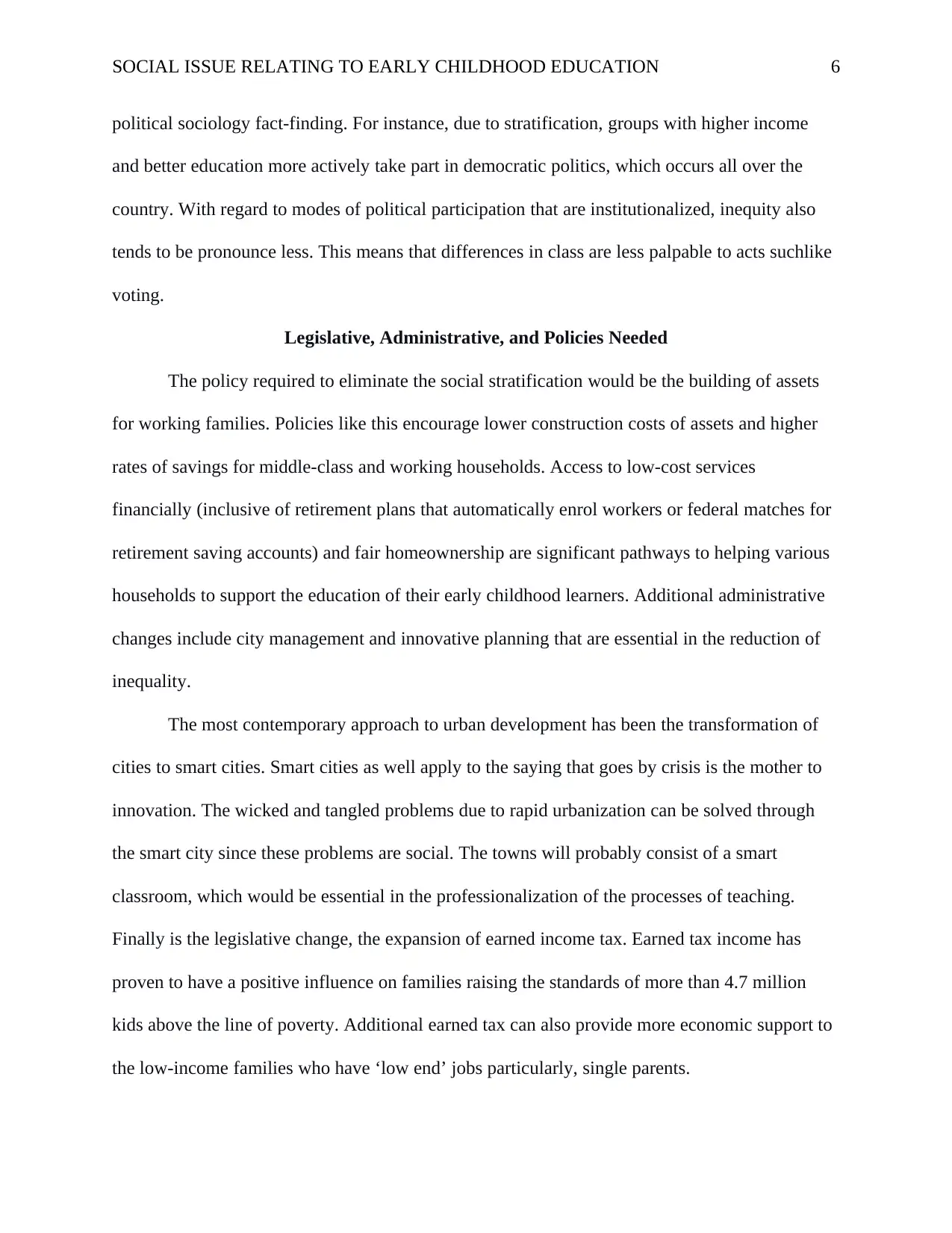
SOCIAL ISSUE RELATING TO EARLY CHILDHOOD EDUCATION 6
political sociology fact-finding. For instance, due to stratification, groups with higher income
and better education more actively take part in democratic politics, which occurs all over the
country. With regard to modes of political participation that are institutionalized, inequity also
tends to be pronounce less. This means that differences in class are less palpable to acts suchlike
voting.
Legislative, Administrative, and Policies Needed
The policy required to eliminate the social stratification would be the building of assets
for working families. Policies like this encourage lower construction costs of assets and higher
rates of savings for middle-class and working households. Access to low-cost services
financially (inclusive of retirement plans that automatically enrol workers or federal matches for
retirement saving accounts) and fair homeownership are significant pathways to helping various
households to support the education of their early childhood learners. Additional administrative
changes include city management and innovative planning that are essential in the reduction of
inequality.
The most contemporary approach to urban development has been the transformation of
cities to smart cities. Smart cities as well apply to the saying that goes by crisis is the mother to
innovation. The wicked and tangled problems due to rapid urbanization can be solved through
the smart city since these problems are social. The towns will probably consist of a smart
classroom, which would be essential in the professionalization of the processes of teaching.
Finally is the legislative change, the expansion of earned income tax. Earned tax income has
proven to have a positive influence on families raising the standards of more than 4.7 million
kids above the line of poverty. Additional earned tax can also provide more economic support to
the low-income families who have ‘low end’ jobs particularly, single parents.
political sociology fact-finding. For instance, due to stratification, groups with higher income
and better education more actively take part in democratic politics, which occurs all over the
country. With regard to modes of political participation that are institutionalized, inequity also
tends to be pronounce less. This means that differences in class are less palpable to acts suchlike
voting.
Legislative, Administrative, and Policies Needed
The policy required to eliminate the social stratification would be the building of assets
for working families. Policies like this encourage lower construction costs of assets and higher
rates of savings for middle-class and working households. Access to low-cost services
financially (inclusive of retirement plans that automatically enrol workers or federal matches for
retirement saving accounts) and fair homeownership are significant pathways to helping various
households to support the education of their early childhood learners. Additional administrative
changes include city management and innovative planning that are essential in the reduction of
inequality.
The most contemporary approach to urban development has been the transformation of
cities to smart cities. Smart cities as well apply to the saying that goes by crisis is the mother to
innovation. The wicked and tangled problems due to rapid urbanization can be solved through
the smart city since these problems are social. The towns will probably consist of a smart
classroom, which would be essential in the professionalization of the processes of teaching.
Finally is the legislative change, the expansion of earned income tax. Earned tax income has
proven to have a positive influence on families raising the standards of more than 4.7 million
kids above the line of poverty. Additional earned tax can also provide more economic support to
the low-income families who have ‘low end’ jobs particularly, single parents.
⊘ This is a preview!⊘
Do you want full access?
Subscribe today to unlock all pages.

Trusted by 1+ million students worldwide
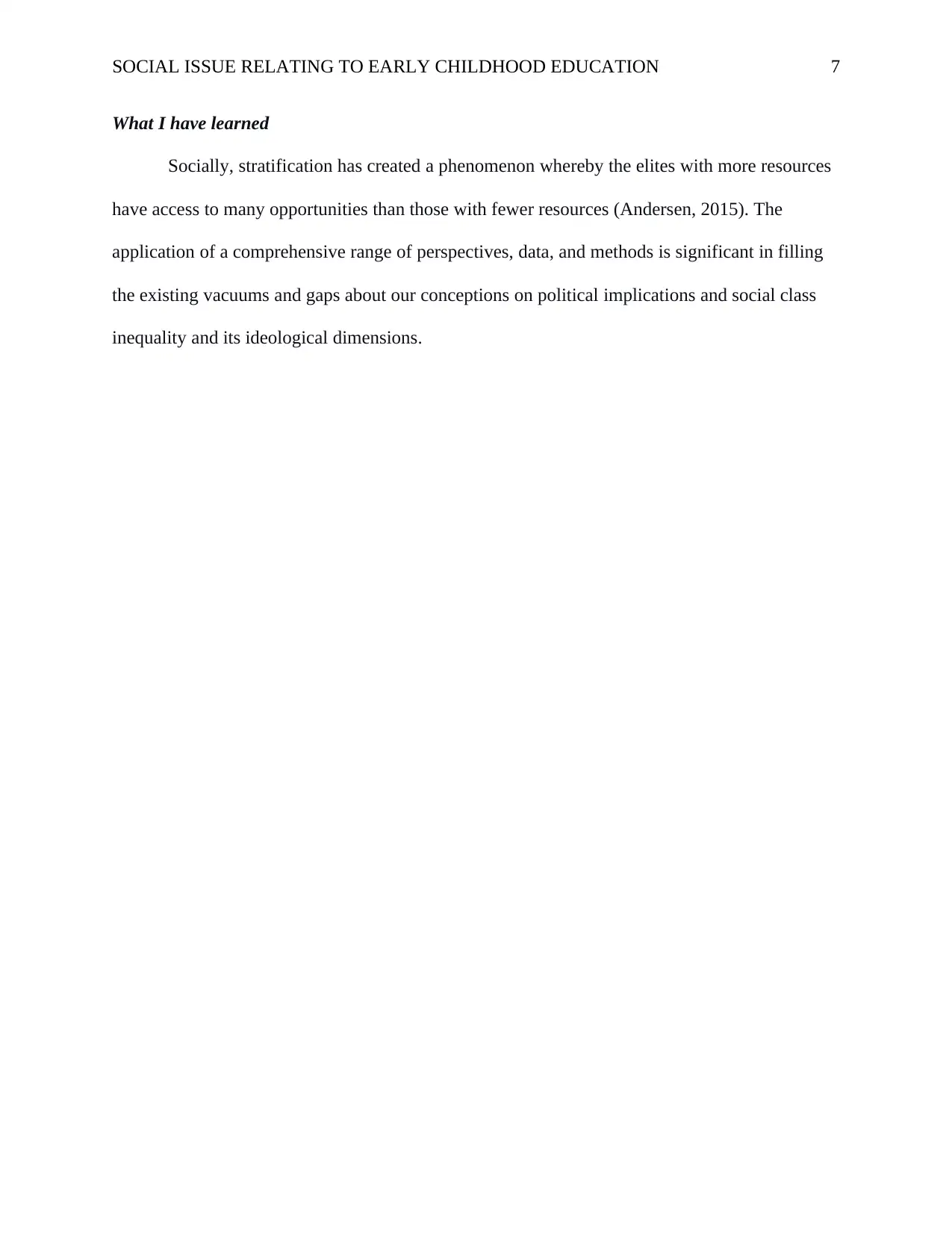
SOCIAL ISSUE RELATING TO EARLY CHILDHOOD EDUCATION 7
What I have learned
Socially, stratification has created a phenomenon whereby the elites with more resources
have access to many opportunities than those with fewer resources (Andersen, 2015). The
application of a comprehensive range of perspectives, data, and methods is significant in filling
the existing vacuums and gaps about our conceptions on political implications and social class
inequality and its ideological dimensions.
What I have learned
Socially, stratification has created a phenomenon whereby the elites with more resources
have access to many opportunities than those with fewer resources (Andersen, 2015). The
application of a comprehensive range of perspectives, data, and methods is significant in filling
the existing vacuums and gaps about our conceptions on political implications and social class
inequality and its ideological dimensions.
Paraphrase This Document
Need a fresh take? Get an instant paraphrase of this document with our AI Paraphraser
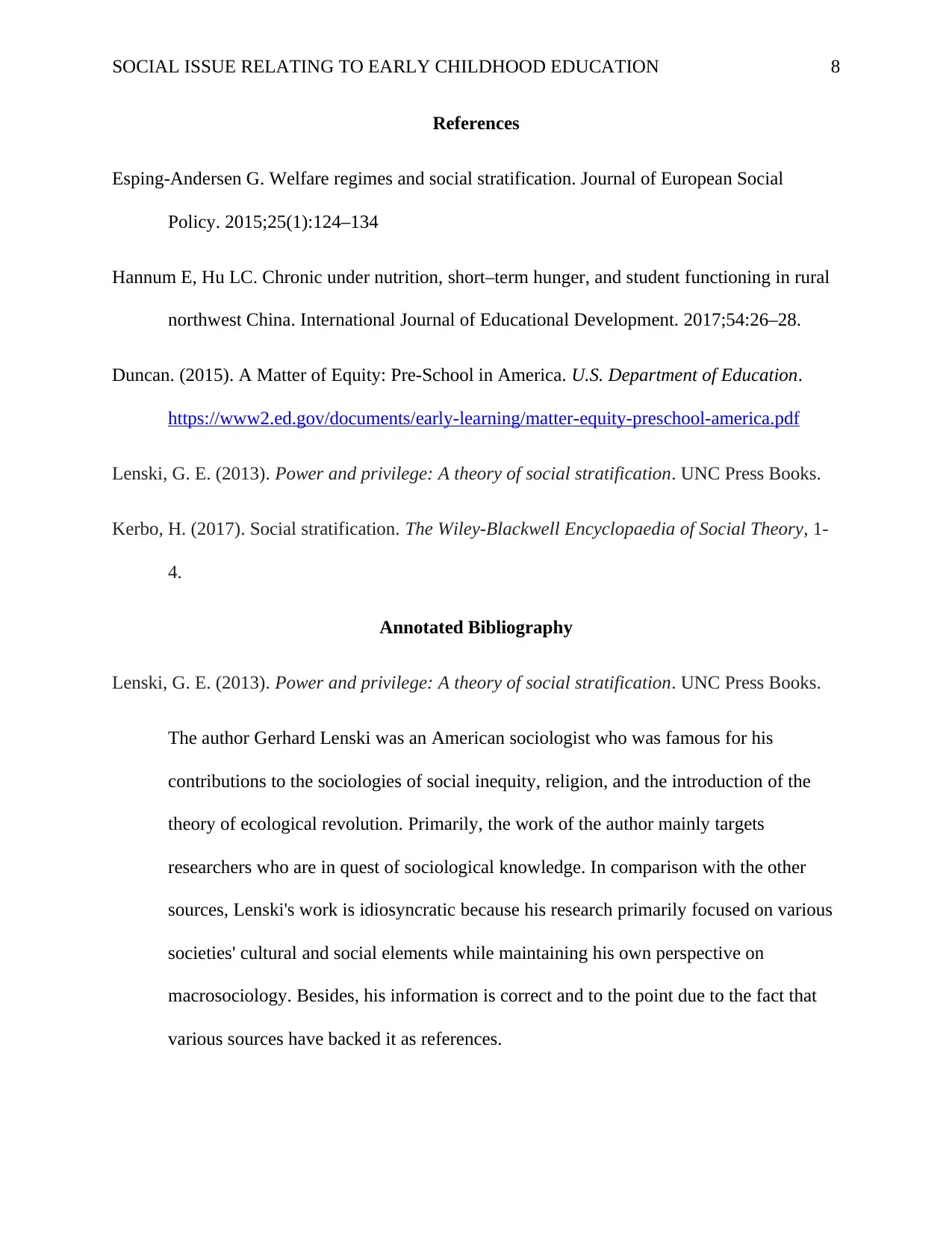
SOCIAL ISSUE RELATING TO EARLY CHILDHOOD EDUCATION 8
References
Esping-Andersen G. Welfare regimes and social stratification. Journal of European Social
Policy. 2015;25(1):124–134
Hannum E, Hu LC. Chronic under nutrition, short–term hunger, and student functioning in rural
northwest China. International Journal of Educational Development. 2017;54:26–28.
Duncan. (2015). A Matter of Equity: Pre-School in America. U.S. Department of Education.
https://www2.ed.gov/documents/early-learning/matter-equity-preschool-america.pdf
Lenski, G. E. (2013). Power and privilege: A theory of social stratification. UNC Press Books.
Kerbo, H. (2017). Social stratification. The Wiley‐Blackwell Encyclopaedia of Social Theory, 1-
4.
Annotated Bibliography
Lenski, G. E. (2013). Power and privilege: A theory of social stratification. UNC Press Books.
The author Gerhard Lenski was an American sociologist who was famous for his
contributions to the sociologies of social inequity, religion, and the introduction of the
theory of ecological revolution. Primarily, the work of the author mainly targets
researchers who are in quest of sociological knowledge. In comparison with the other
sources, Lenski's work is idiosyncratic because his research primarily focused on various
societies' cultural and social elements while maintaining his own perspective on
macrosociology. Besides, his information is correct and to the point due to the fact that
various sources have backed it as references.
References
Esping-Andersen G. Welfare regimes and social stratification. Journal of European Social
Policy. 2015;25(1):124–134
Hannum E, Hu LC. Chronic under nutrition, short–term hunger, and student functioning in rural
northwest China. International Journal of Educational Development. 2017;54:26–28.
Duncan. (2015). A Matter of Equity: Pre-School in America. U.S. Department of Education.
https://www2.ed.gov/documents/early-learning/matter-equity-preschool-america.pdf
Lenski, G. E. (2013). Power and privilege: A theory of social stratification. UNC Press Books.
Kerbo, H. (2017). Social stratification. The Wiley‐Blackwell Encyclopaedia of Social Theory, 1-
4.
Annotated Bibliography
Lenski, G. E. (2013). Power and privilege: A theory of social stratification. UNC Press Books.
The author Gerhard Lenski was an American sociologist who was famous for his
contributions to the sociologies of social inequity, religion, and the introduction of the
theory of ecological revolution. Primarily, the work of the author mainly targets
researchers who are in quest of sociological knowledge. In comparison with the other
sources, Lenski's work is idiosyncratic because his research primarily focused on various
societies' cultural and social elements while maintaining his own perspective on
macrosociology. Besides, his information is correct and to the point due to the fact that
various sources have backed it as references.
1 out of 8
Related Documents
Your All-in-One AI-Powered Toolkit for Academic Success.
+13062052269
info@desklib.com
Available 24*7 on WhatsApp / Email
![[object Object]](/_next/static/media/star-bottom.7253800d.svg)
Unlock your academic potential
Copyright © 2020–2025 A2Z Services. All Rights Reserved. Developed and managed by ZUCOL.





